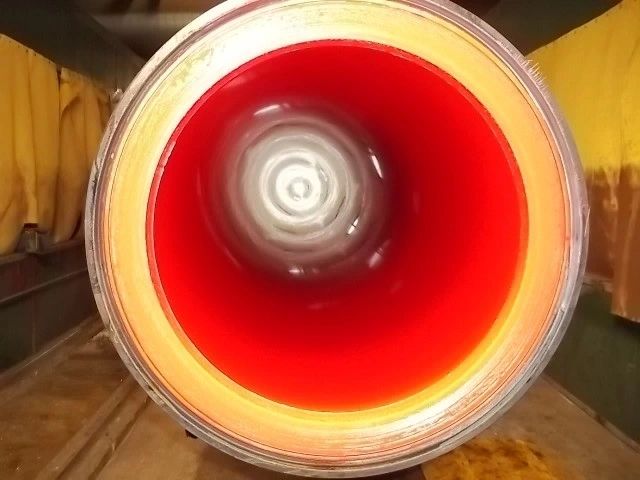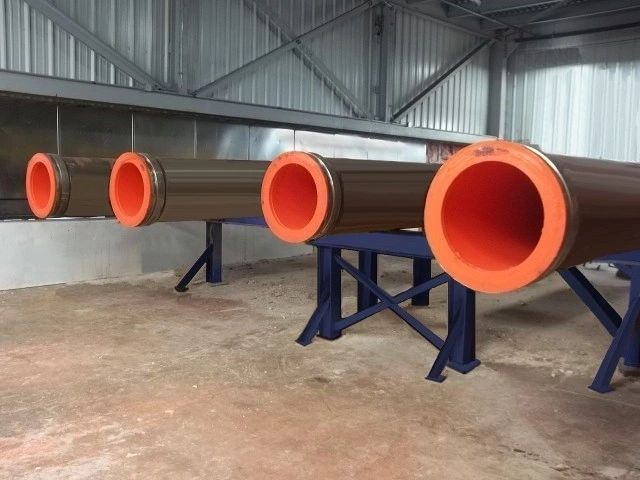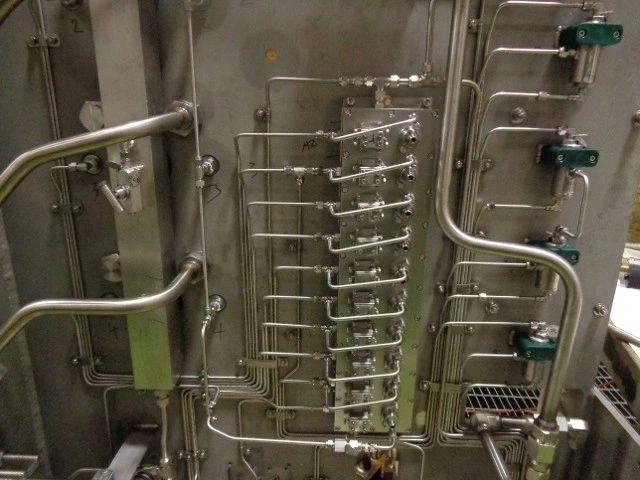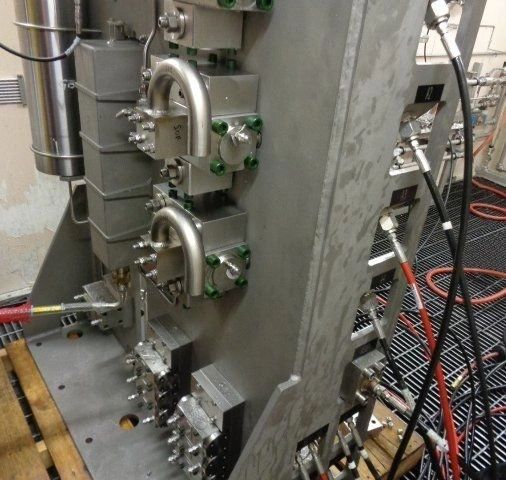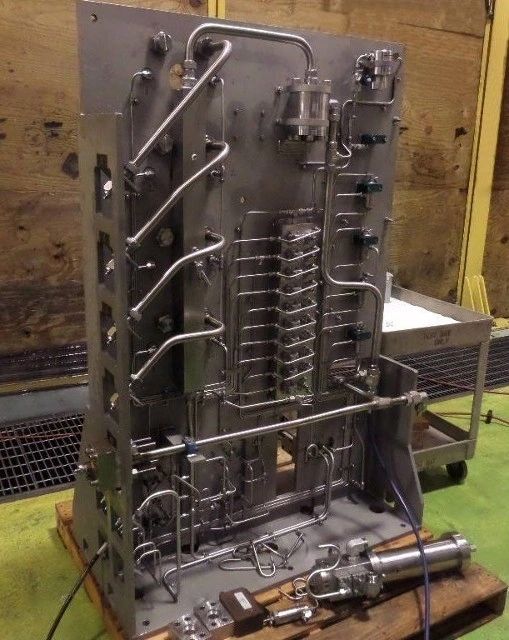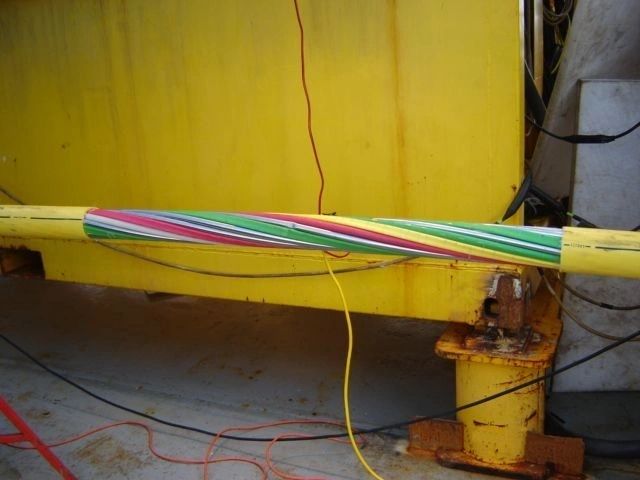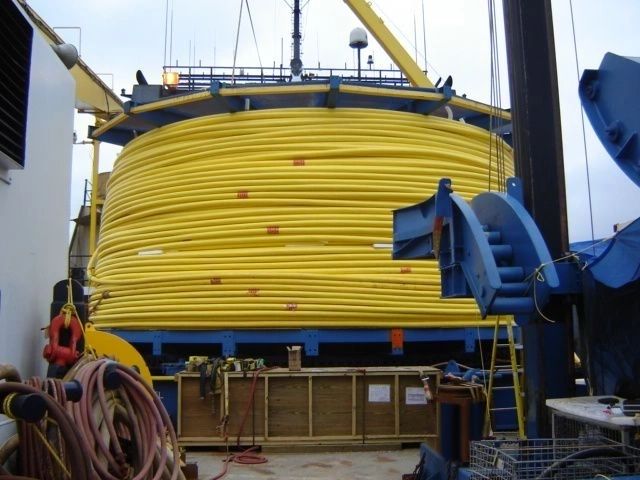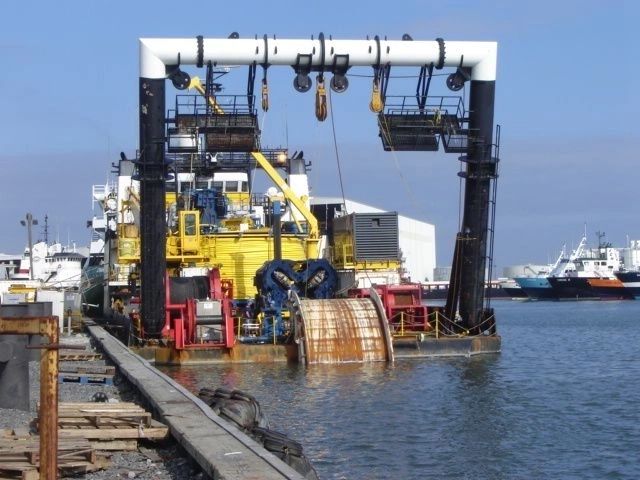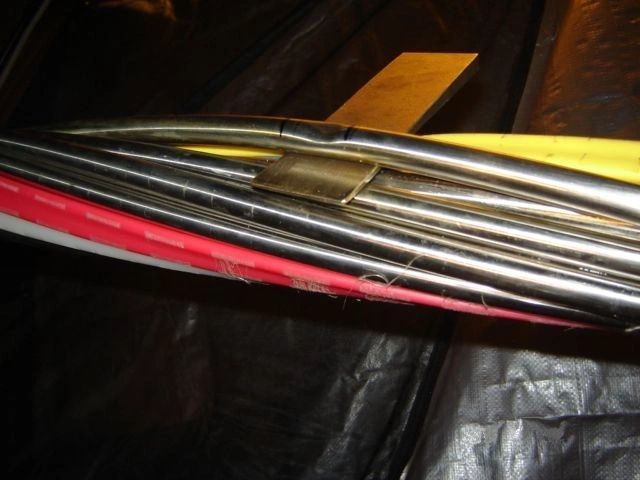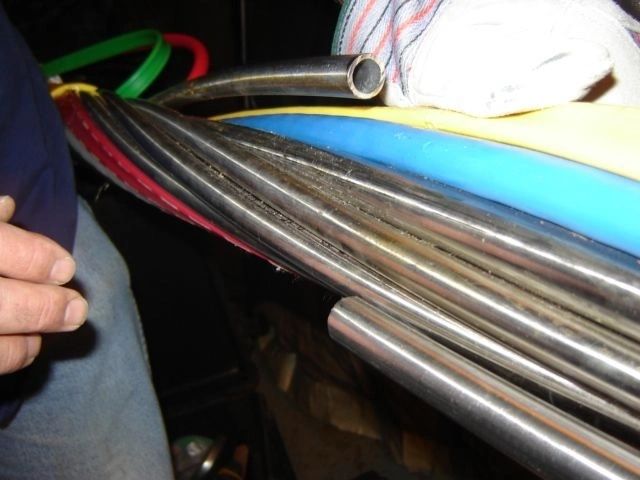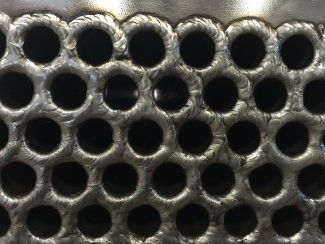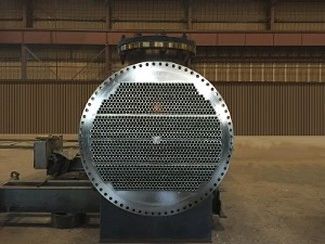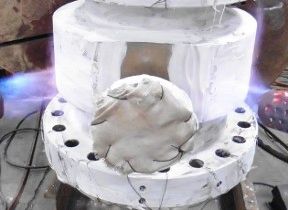Rubber & Urethane Lined Piping
Other commodities inspected by Decundi Inspection Services personnel include inspections performed during the application of urethane lining on the I.D. of 30" diameter piping with Victaulic Ring End Connections is preceded by abrasive blasting on the I.D. of piping, carried out to SSPC-SP 10/NACE No. 2 Near White Blast Cleaning. Anchor profile readings are taken on the abrasive blasted surfaces for compliance with project specifications. Application of primer(s) is applied in two stages, one to the substrate of the 30" diameter piping, and application of another primer is applied atop the primer on the substrate. The curing of these primers is carried out according to specification and is followed by the application of rubber lining and urethane lining.
Cleaning of the two cut ends at the damage at a local area on SA/789 UNS S32750 super duplex umbilical tubing was carried out and was followed by welding the first pass of a two-pass fillet weld, deposited at either end of the coupling to tube attachment and after cool-down of these fillet welds, visible dye penetrant testing was carried out with a satisfactory result. The second pass of the required two-pass fillet weld was deposited at either end of the coupling to tube attachment, and after the cool-down of these fillet welds, visible dye penetrant testing was again carried out with satisfactory results.
Dimensional inspection of the completed fillet welds found the welds to have “equal leg” and “sufficient throat.” The welds, as measured, were found to be a 1/8” fillet. No undercut was noted on the tubes or the coupling; additionally, no defects in the form of arc-strikes were noted on either the tubes or the coupling. The weld repair of the previously damaged umbilical tube was found to be satisfactory. Flushing of the repaired umbilical tube was carried out to achieve the required NAS 1638 class 6 cleanliness. The flushing of the tube achieved satisfactory results. Spooling of the SA/789 UNS S32750 super duplex umbilical tubing using an Under Roller System with independently driven base-mounted rollers and Carousel was carried out to completion with satisfactory results.
Repair of Damage at Local Area of Umbilical Tubing
Repair of damage at the local area on SA/789 UNS S32750 super duplex umbilical tubing material with 25% chromium content, including review of the material test report for compliance with the chemical composition and mechanical properties of the coupling and electrode rod required for the weld repair of the umbilical tubing. Weld repair of damage at the local area on SA/789 UNS S32750 super duplex umbilical tubing carried out by GTAW manual process (single J groove) using 1/16" Ø electrode rods, which are flagged tagged with the consumable type at both ends. Verification of the welder performance qualification record was carried out for assurance that the welders are qualified to make these welds carried with satisfactory results.
Isolation of other tubes in the umbilical bundle was carried out using a wedge made from bronze material, and a fire-resistant blanket was inserted between the damaged tube and the good tubes and fillers. Visual inspections found no nicks or scratched areas after cutting and removal of the damage at the local area on the umbilical tubing. Deburring on the I.D. and O.D. of the cut tubing was also carried out. After the damaged tubing was cut, verification was made to ensure that the correct tube was cut by applying a slight flow of air inside the cut tubing in order to see which umbilical tube the hydraulic fluid would flow from; verification for the correct tubing to be repaired was satisfactory.

Heat Exchanger
Decundi Inspection Services have many inspection personnel who are highly skilled in the manufacturing process for Heat Exchangers. Before the start of the manufacture of Heat Exchangers, Decundi inspectors perform inspection checks for the material type of the tubes and also the tube sheet for the tube bundle, and in some cases, for weld overlay and the thickness of the weld overlay on the face of carbon steel tube sheet. Inspections are also carried out for verification of the material type for the shell, channel, cover, and flanges used for the fabrication of Heat Exchangers. In addition to the above, Decundi Inspectors also carry out inspection checks for the 1/64" X 1/8" TEMA grooves inside the tube holes on the tube sheet and also fractionize dimension X 45° chamfer on the outer face of the tube sheet plus inspection for verification of consumable required for welding at the tube to tube sheet joints.
During fabrication of the commodity commented on herein, Decundi inspectors also perform an inspection for insertion of the tube bundle to the shell of the Exchanger, and after bundle insertion and completion of seal welding or strength welding at the tube to tube sheet (depending on scope), inspections are also carried out for verification that the I.D. of some tubes is not blocked, restricted or plugged (refer to bundle inspection above) plus rolling of the tubes after welding. Inspection checks carried out by Decundi inspectors during the fabrication of Heat Exchangers also include checks for assurance that impingement rods (or plates) are installed at the Inlet nozzle, witnessing of helium leak testing, liquid penetrant testing of the welds at the tube-to-tube sheet, witnessing of hydro testing on the shell-side and tube-side of the Exchanger and inspection during abrasive blasting and painting of the Exchanger.
Read More
It is the culture of Decundi that we assure that our inspection personnel will carry out their inspection duties so that quality equipment and commodity are delivered to our clients by diligently carrying out inspections during the fabrication and testing of Heat Exchangers (commented on above) and all every other type of equipment used by Energy companies for the processing of Crude Oil into Gasoline, Diesel Fuel, Jet Fuel, and other commercial products.
Wellhead Assembly
Decundi Inspection Services have many inspectors who are highly skilled for carrying inspections during the fabrication and testing ow Wellhead assembly where these activities are noted to be but not limited to inspection of the fit-up of Flange Outlets with 0.12" thick X 0.25" long integral backing material where the fit-up of these Flange Outlets are attached to Wellhead assembly noted to be Casing Spool and Cross Flanged Body. Inspection for the fit-up of the Flange Outlet (see integral backing material above) to the Wellhead assembly, including checks for the weld preparation for the set-in of the Wellhead assembly for accommodating the Flange Outlets plus checks for the Flange rating, are carried out by Decundi inspectors for compliance with drawings.
In addition, the inspection checks carried out by Decundi inspection personnel for Flange Outlets to Wellhead assembly include a check for the root, which is generally noted to have a 1/8" root gap. The progression of inspection for the commodities commented on above is carried out for five (5) parameters associated with the fit-up of Flange Outlets to Wellhead assembly, which includes checks for orientation, elevation, projection, 2-hole, and levelness of the Flange Outlet in relation to the Wellhead assembly and these tasks are also supported by Decundi inspection personnel prior to welding of the assembly.
Generally, welding of Flange Outlets to Wellhead assembly is carried out by deposition of the root bead by employing the GTAW process and is generally followed by the SMAW process. Decundi inspection personnel carry out the assurance that the electrode rods for GTAW are AWS – ER100S-G as stated on the WPS, and in addition, inspection checks are carried out for assurance that the electrode rods for the SMAW process are AWS – E10018-D2 H4R electrodes as stated on the WPS and in addition, electrode rods type listed above are checked by Decundi inspection personnel for compliance for the welding of Low Alloy Steel AISI 4130 (UNS G41300) with 63.3 KSI minimum yield in the normalized condition.
Inspection for preheat of Flange Outlets and Wellhead assembly where the preheat temperature is stated on the WPS is carried out prior to welding of the root bead by GTAW process. During welding of the root bead, Decundi inspection personnel carry out inspection checks of the welding machine, set to direct current and reverse polarity for compliance with QW-409 of the WPS. The flow rate of the 99.98% argon shielding gas plus inspection checks for amperage and voltage are also carried out by Decundi inspection personnel during the welding of the root bead for compliance with the WPS.
Before carrying out welding by the SMAW process, Decundi inspection personnel carry out an inspection check for assurance that the welding machine is set to direct current and straight polarity in accordance with QW-409 of the WPS. During the continuation of welding of Flange Outlets to Wellhead assembly, inspection checks are carried out for welding parameters for the fill passes and cap bead carried out by employing the SMAW process and by use of AWS- E10018-D2 H4R electrodes. Inspections during welding of these Wellhead assemblies also include checking for the interpass temperature and maintenance as required to maintain preheat plus visual inspection for assurance that proper interpass cleaning is being carried out for the removal of the slag, buckshot, and brown soot (silicon residue) at the bevel being filled and adjacent to the area being welded. After completion of welding, post weld heat treatment of these Wellhead assemblies is carried out.
Installation of Equipment Offshore
Decundi Inspection Services personnel carry out inspections during the installation, hook-up, and commissioning of a bank of 20" Ø alloy 2205 Hairpin Heat Exchangers made from alloy 2205 tri-segmental baffles, 0.0625" w.t. x ¾" Ø SA-789 UNS S32750 tubes and alloy 2205 tube sheet where these equipments are on the main deck of an offshore production platform. Installation and hook-up of these 20" Ø alloy 2205 Hairpin Heat Exchangers includes the installation of flanged fiberglass reinforced piping (FRP), fiberglass reinforced tees, and fiberglass reinforced elbows, all made from vinyl ester resins. These fiber glasses reinforced piping are connected to alloy 2205 flanges on the Hairpin Heat Exchangers. Additional installations include the installation of manually operated butterfly valves for controlling the process flow through this FRP ( piping ) system.
Inspection activities also include the installation of galvanized grating with support clips, an open drain system below the main deck and visible in the cellar deck, closed drain, demolition, and removal of decommissioned equipment and piping on the cellar deck. Reinstallation of new equipment on the cellar deck includes but is not limited to vessels, pressure relief valves (PSV), indicating gauges, vertical Pump and motor, piping, "Y" type strainers, valves, verification of tagging and P&ID walk down of piping and systems. Inspections also include the commissioning of equipment and witnessing of start-up of the production platform at first gas.


